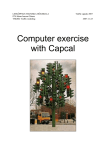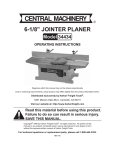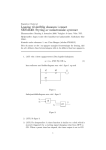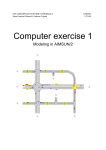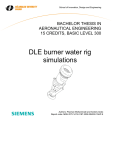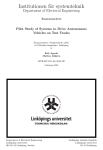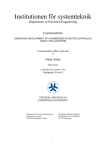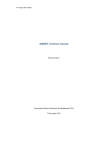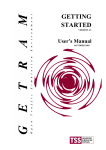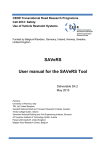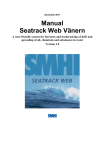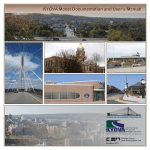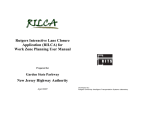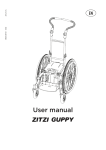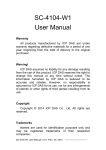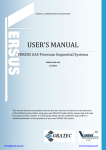Download LINKPINGS TEKNISKA HGSKOLA
Transcript
ITN/LINKÖPINGS TEKNISKA HÖGSKOLA Johan Janson Olstam Project 2008 1/25/2008 PROJECT ASSIGNMENT - HINTS TNK082 Traffic simulation Preface This document includes experiences from previous projects and master thesis. The document is a draft and has not been extensively edited and maybe extended during the course. Some parts of it may be obvious, but I think that you will have great use of this document. Finally I want add that you will not be able to conduct each part of the project as extensively as should be needed in a real traffic simulation project (limited measurement possibilities, limited time, etc.). This is neither the idea, it is more important that you address and conduct the vital things in each step that should be included in a simulation project. Plan your 320 man-hours well! Data collection Maps Information on how to export a suitable map for your intersection from the available shape-files over Norrköping can be found on the course webpage in the document map exporting. Maps or air photos can be imported to TEDI, to be used as background pictures for the network coding. It is important that the scale of the imported picture is correct. One can control if the scale is correct by measuring the length or width of a section on the blue-print or in reality. Then create a section in TEDI with the measured length and width and adjust the scale of the background picture until the geometry of the section in the background picture and in TEDI are equivalent. Information on how to import background pictures and adjusting their scales can be found in the TEDI-manual, chapter 3.5.5 Background. Traffic signal Traffic signal schemes will be handed out for those groups that are assigned a signal controlled intersection. These signal control schemes shall be returned to Johan when the project is finished. The signal control schemes include information about phase configuration, green times, detector placements, etc. Most of the intersections are controlled by vehicle actuated traffic signals and it is possible to model such traffic signals in TEDI/AIMSUN. However, this is compulsory. It is ok to simplify the modeling of the signal control by using a fixed-time control instead. In the case of using a fixed-time signal, you have to estimate green times by measuring the green time at the real intersection. Measure the green times in e.g. 10 signal cycles and then calculate the average green time for each phase. Visit the intersection Start the project by visiting the intersection and study how the traffic behave and how the intersection and its environments look like. Good knowledge about the local conditions is very important when creating and using traffic simulation models. • Where are queues created? • How do the lane markings look like? Page 1(4) • Is wide lanes used as two lanes? • Do some turn lanes have limited storage capacity? • Are the road users acting in any special way in the intersection? • Etc. Measurements of traffic flows, etc Traffic flows and turning proportions are two important input data to a traffic simulation model. These data has to be collected manually. The municipal of Norrköping has AADT (Average Annual Daily Traffic) measurements on several links. However, from these measurements is it only possible to make approximations on the peek-hour traffic. There is neither no good way to approximate turning proportions from AADT measurements. You will due to the limited time not be able to conduct as many measurements as needed for getting enough confidence on mean values. This is less important in this “student” project but is of course essential in real projects. • Find the peek hour It is often most interesting to study the traffic during the peek-hour. You have to guess at which time the peek-hour occurs in your intersections. A good start is to discuss whether the highest peek-hour is the morning or the afternoon peek-hour. • Collect data in intervals Measure turn proportions and traffic flows as detailed as possible, e.g. in 15 minutes intervals. This makes it possible to observe changes over time. It should not be any problems to measure turn proportions for one intersection on 4 persons. In signal controlled intersections is it possible to use that not all traffic streams are allowed to drive at the same time, i.e. one person can measure one traffic stream during one signal phase and another stream during the next phase. It is of course also ok if project groups help each other with the data collection. • Count different vehicle types separately Count e.g. cars, heavy vehicle, pedestrians, etc. separately. Note that this is only necessary if there is a considerable share of a certain vehicle type. If e.g. the share of heavy vehicles is low, for instance 1-2 % of the total flow, it is ok to include them in the car category. It is only interesting to measure pedestrian flows if they affect the vehicle traffic, for example pedestrians are affecting turning vehicles. • How to measure turn proportions? To get turn proportions, calculate how many vehicles that turn right, left and straight forward. Divide each number with the total sum (which also is the flow on the section). • SAVE YOUR NOTES FROM THE MEASUREMENTS!!! They can be invaluable if questions or hesitations arise later on. • Be aware of the School holiday at week 8 There will be a school holiday during week 8 which implies less traffic compared to the other weeks. Avoid data collection during this week since you can not do any complementary data collection under similar traffic conditions. • Take warm clothes!!! Calibration and Validation When the simulation model has been created in TEDI it has to be calibrated and validated. For this you need data as for example travel times, queue lengths, travel speeds, etc. It is important that this data is consistent with your traffic flow counts since the travel time etc depends on the traffic flow. Thus, you should collect these data at the same time as you collect your flow data or at another time with equal/similar weather and traffic conditions. You will probably not be able to collect enough data Page 2(4) to divide the total data set it into one calibration set and one validation set. If not, you are only able to calibrate your model, which need to be kept in mind when conducting the analysis. The following are some hints on how to collect data about queue lengths and travel times manually. • Queue lengths Queue lengths can easily be measured by counting the number of vehicles in queue. However, there are several different definitions of a queue. If you want to compare your measurements to the queue statistics that AIMSUN generates you have to measure the queue lengths according to the definition used in AIMSUN, see the User manual. Another way is to make your own definition of queue lengths, e.g. the number of vehicles in queue at the end of the red period in the traffic signal. Then you can measure this queue length in the real network and in AIMSUN (by counting vehicles in the animation). • Travel times and travel speeds Travel times and indirectly the travel speed can be measured by observing the time it takes for vehicles to travel a on beforehand specified distance. Find two good reference points between which it is easy to measure the distance either in reality or in a map. Then it is possible to calculate the travel speed or compare the travel time with the corresponding travel time in AIMSUN. Travel speeds can also be measured using a car. This is not required since not everyone has a car or a driving license. However, if you do measurements using a car you have to be at least 2 persons in it, one that drives the car and one that conducts the measurements. Calibration of acceleration The former KTS-student Johan Larsson found a clever way to calibrate the acceleration parameters in AIMSUN using manually collected measurements. He measured how long time it took for a vehicle to accelerate from 0 speed up to some wear near the desired speed. What he did was to measure the time it takes for the first vehicle waiting at the stop line in a traffic signal to travel to a defined reference point at which most vehicles should have reached their desired speed for the current road section. The corresponding measurements where conducted in AIMSUN and the parameters where then adjusted until the average and the deviation from the AIMSUN measurements are sufficiently close to the real measurements. A hint on start values for the different driving related parameters can be found in appendix 1 (bilaga 1) in Johan’s master thesis (a link to the thesis Simulering av trafik på Kungsgatan i Norrköping is available on the course homepage ). Maximum speed through intersections It is in TEDI possible to set the highest speed that a vehicle can travel at trough an intersection. The default option is that TEDI auto evaluates the maximum speed from the geometry for each turning. It is also possible to specify other values by un-checking the auto evaluate check box. You can estimate these maximum speeds either by using a car or by observations at the road side. Analysis The important thing in this project is not come up with new revolutionary ideas on how to change the intersection. The important thing is that you analyze and compare the current design with some alternative design. It is in real projects quite common that the customer already have decided which alternative designs that should be tested and that your job as a consultant is to evaluate the different alternatives. Which output data that are interesting to study always depends on the characteristics of the network studied and which scenarios that should be investigated. All out put data is not always interesting; one therefore has to think on which output variables that are most interesting for this evaluation. There are also different ways to compare alternative designs. One should of course compare the performance of the different designs at the current traffic conditions. However, an interesting additional comparison is to evaluate the performance at future traffic conditions. The amount of traffic Page 3(4) increases in average with 1-2 % each year. It can for example be interesting to study the performance of the different designs for the anticipated traffic conditions 20-25 years from now? The report Your work should be presented in a well written report. Use appendices for presentation of large data sets. The report should include clear descriptions on: • the intersection and the current traffic conditions at it • how the data collection has been conducted • the collected input data • the utilized parameter settings • how calibration and validation has been conducted • the result of the calibration and validation • the analysis should be detailed and supported by output data from the model • possible sources of error should be documented and discussed It should in principle be possible to conduct the modeling and simulation again based on the information presented in the report!!! Brake a leg! Page 4(4)




